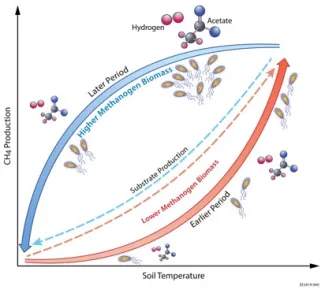Wetland CH4 Flux Temperature Hysteresis Explained by Substrate Availability and Microbial Activity
Using a mechanistic ecosystem model, ecosys, to demonstrate that static temperature relations cannot accurately predict wetland CH4 production and emission rates due to substrate-mediated microbial and abiotic interactions.
To demonstrate that static temperature relations cannot accurately predict wetland CH4 production and emission rates due to substrate-mediated microbial and abiotic interactions.
This study ran the ecosys model across Alaskan and Swedish sites to examine mechanisms leading to the observed apparent CH4 emission hysteresis to temperature.
Substantial intra-seasonal variations in apparent CH4 emission temperature dependence are observed and modeled in Alaskan (Utqiaġvik) and Swedish tundra, challenging the fixed temperature relations prescribed in most terrestrial BGC models. The findings demonstrate the uncertainty of inferring CH4 emission or production rates from temperature alone and highlight the need to represent microbial and abiotic interactions in wetland biogeochemical models.
Chang, K.Y., Riley, W. J., Crill, P. M., Grant, R. F., and Saleska, S. R.: Hysteretic temperature sensitivity of wetland CH4 fluxes explained by substrate availability and microbial activity, Biogeosciences, 17, 5849–5860, https://doi.org/10.5194/bg-17-5849-2020, 2020.
This study was funded by the Genomic Science Program of the United States Department of Energy Office of Biological and Environmental Research under the ISOGENIE (DE-SC0016440) and NGEE-Arctic projects under contract DE-AC02-05CH11231 to Lawrence Berkeley National Laboratory and grants from Swedish VR (Vetenskaprådet) and Swedish FORMAS to Patrick M. Crill. We acknowledge the US National Science Foundation MacroSystems program (NSF EF 1241037) support for autochamber measurements between 2013 and 2017. We thank the Abisko Scientific Research Station of the Swedish Polar Research Secretariat for providing the meteorological data.


